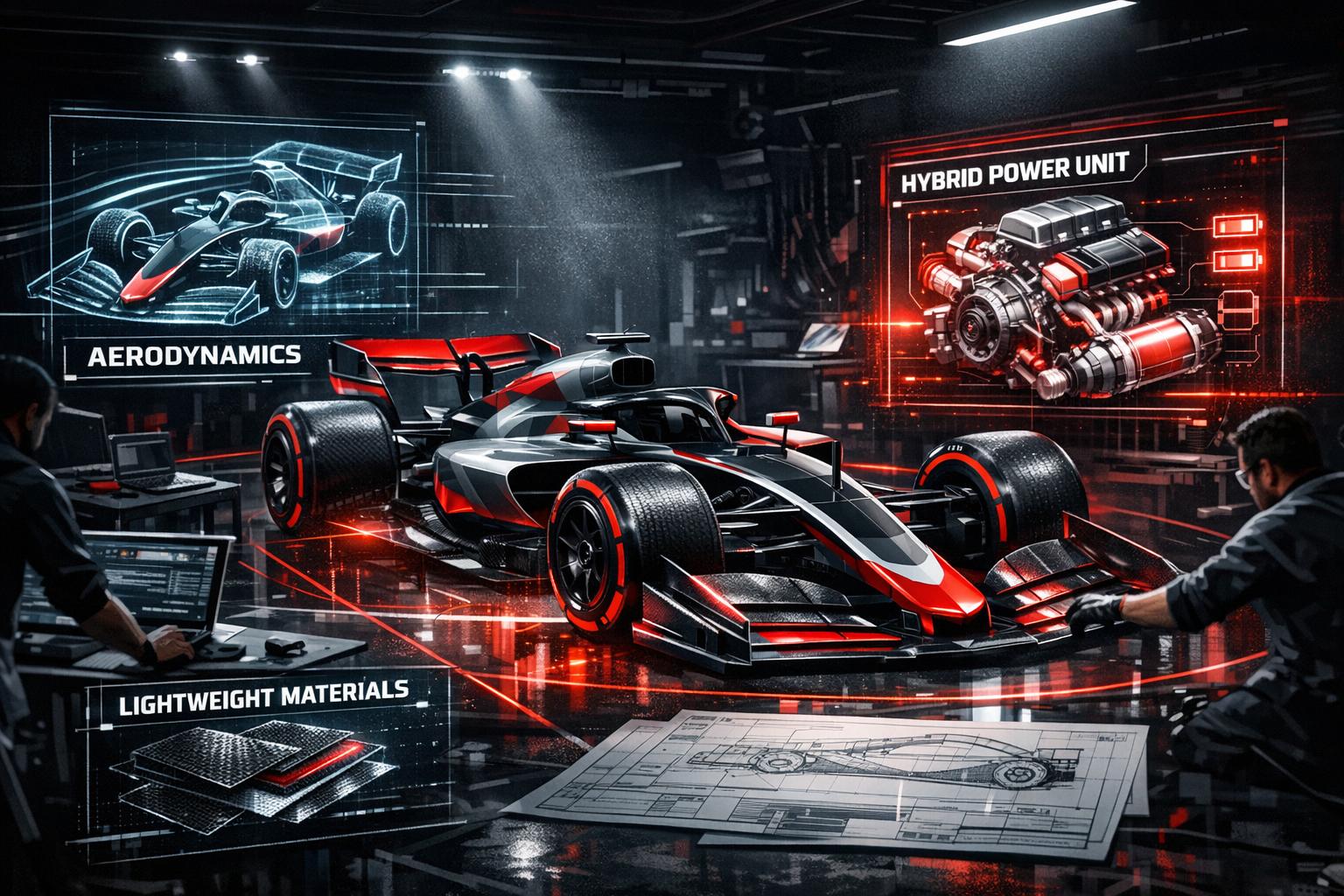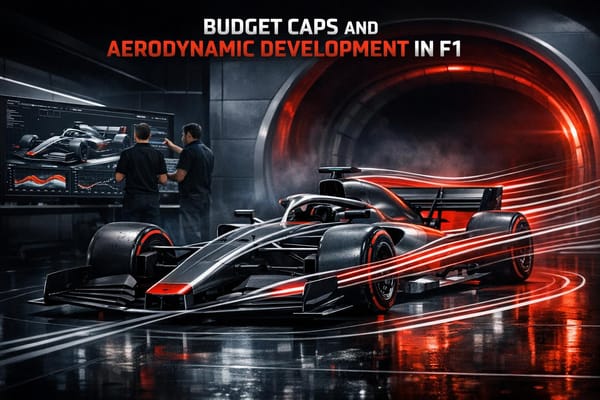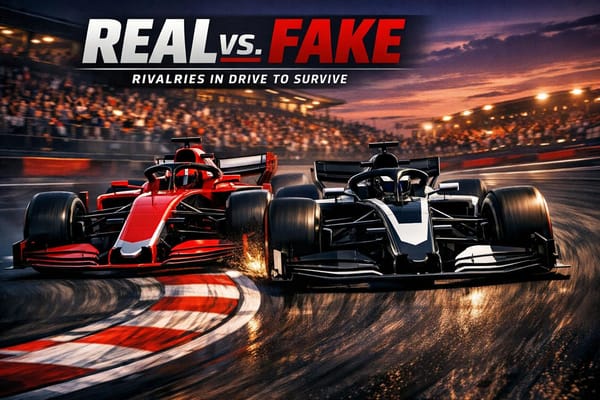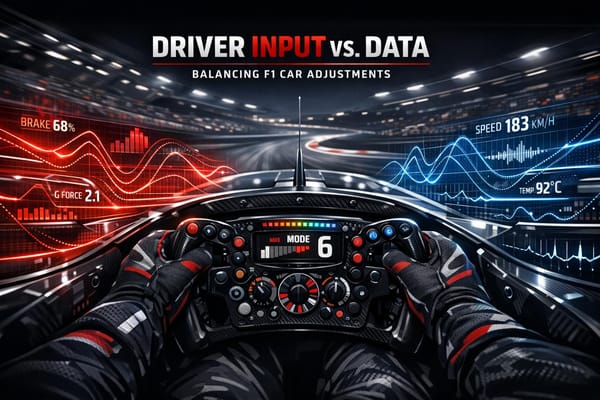Las Vegas Strip Circuit: Glitz, Speed, and Strategy in the Heart of Sin City
Explore the thrilling Las Vegas Strip Circuit, where high-speed racing meets iconic landmarks, strategic challenges, and nighttime spectacle.
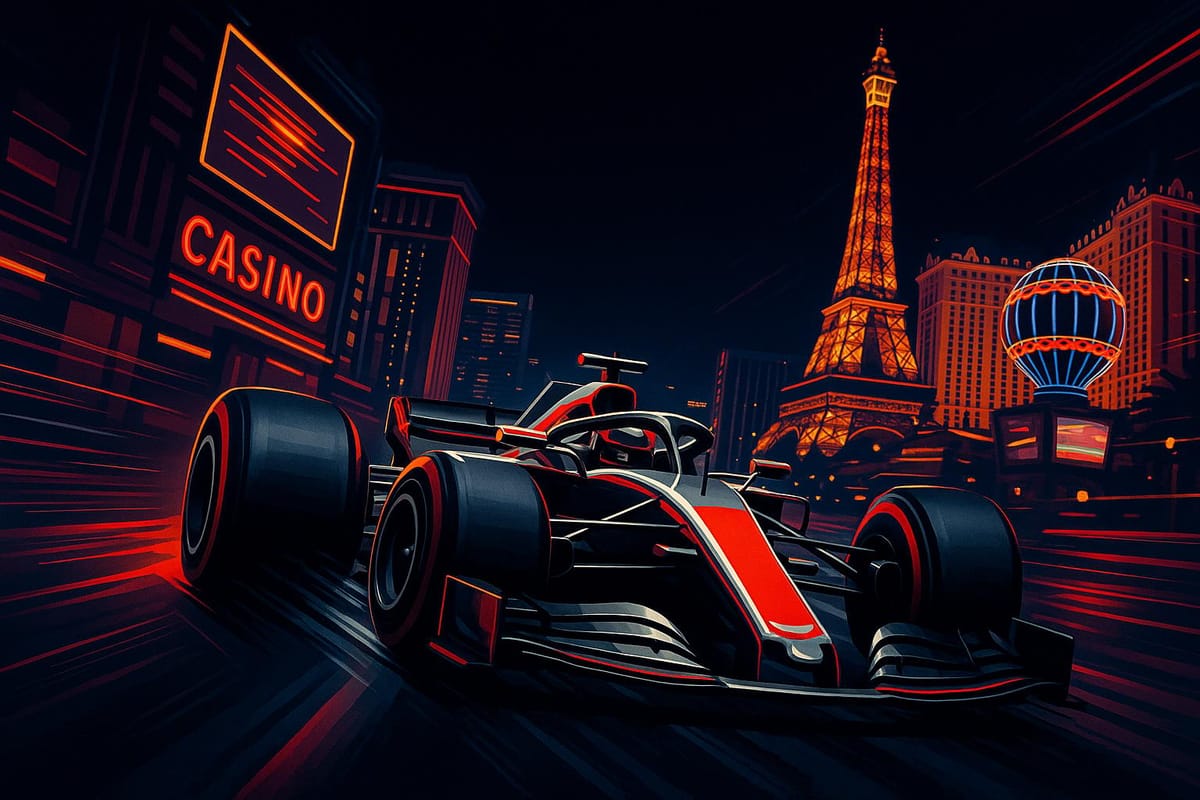
The Las Vegas Strip Circuit has quickly become one of Formula 1's most captivating tracks. Stretching 3.8 miles through the iconic Las Vegas Strip, this street circuit blends high-speed racing with the city's dazzling nightlife. With speeds reaching over 215 mph and 17 challenging corners, it offers a thrilling test for drivers and teams alike. The event's night race format, set against the neon glow of Las Vegas, creates a visual spectacle unmatched in the F1 calendar.
Key highlights:
- Track Length: 3.8 miles (6.201 km)
- Top Speeds: Over 215 mph
- Economic Impact: $934 million in 2024
- Unique Features: Night race, two DRS zones, and landmarks like the Bellagio fountains and MSG Sphere
- Challenges: Tire management, low grip, and balancing speed with cornering precision
This race isn't just about the competition - it's a full-scale entertainment event, combining motorsport with the energy of Las Vegas. From iconic landmarks to strategic challenges, the Las Vegas Grand Prix has redefined what a Formula 1 event can be.
Technical Corners, Rapid Straights ⚡ | Las Vegas GP Track Guide
Circuit Design and Key Features
The Las Vegas Strip Circuit is a striking example of how street circuits can combine the technical demands of Formula One with a world-famous setting. Spanning 6.201 km (3.853 mi) in a counterclockwise direction, it challenges drivers with a mix of high-speed straights and intricate corners, all while weaving past some of the most iconic landmarks in Las Vegas. This blend of speed, precision, and scenery pushes teams to craft clever race strategies.
Layout and Landmarks
The circuit's layout incorporates many of Las Vegas' signature attractions, making the track as much a visual spectacle as a racing challenge. The lap begins at the permanent pit and paddock area, built on a former parking lot purchased by Formula One. Right out of the gate, drivers face a hairpin turn that sets the tone for the lap.
From there, the track flows into a right-hand turn, leading cars onto a 0.5-mile stretch along Koval Lane before hitting a sharp 90-degree right turn. As the race progresses, drivers navigate a sweeping left turn around the MSG Sphere, followed by a tight left-right section that transitions onto Sands Avenue. Here, racers encounter two high-speed bends before making a left turn onto the Las Vegas Strip. This iconic section takes them past landmarks like Caesars Palace, Bellagio, and Paris Las Vegas, delivering a stunning visual experience.
The final sector challenges drivers with a series of three slow corners leading onto Harmon Avenue, followed by a fast left-hand bend that loops back to the permanent section of the circuit. These transitions create a track designed for both technical finesse and thrilling high-speed action.
High-Speed Straight and DRS Zones
One of the circuit's standout features is its 1.9 km (1.2 mi) straight along the Las Vegas Strip - one of the longest straights in Formula One. On this stretch, cars can hit top speeds of over 215 mph (346 km/h), making it a key area for dramatic moments.
To encourage overtaking, the circuit includes two DRS zones placed at strategic points. With an average lap speed of 144.2 mph (232.1 km/h), the track emphasizes sustained speed and high-performance racing.
Night Racing and Lighting Setup
Built for night racing, the Las Vegas Strip Circuit makes the most of the city's iconic neon glow to enhance the spectacle. The lighting system is carefully designed to balance the demands of racing with the electric atmosphere of Las Vegas, ensuring drivers have clear visibility while maintaining the venue's unique and dramatic ambiance.
Racing and Technical Challenges
The Las Vegas Strip Circuit pushes Formula One teams to their limits, demanding a blend of raw speed and precise technical execution. With drivers spending about 80% of each lap at full throttle, the track forces teams to navigate engineering hurdles that test both car performance and strategic finesse.
Overtaking and Braking Zones
The circuit layout encourages high-stakes overtaking, where both driver skill and car capabilities are put to the test. One standout area is Turn 14, where cars brake hard from 212 mph down to just 50 mph. This creates a prime opportunity for overtaking but also demands flawless braking performance.
In the 2023 Las Vegas Grand Prix, drivers executed 81 overtaking moves. Mattia Spini, senior race engineer at VCARB, highlighted the track's design, saying:
"It's definitely an overtaking-friendly layout"
Key overtaking zones, like Turns 5 and 14, are strategically placed at the end of long straights where DRS provides maximum impact. Charles Leclerc demonstrated the circuit's speed potential in 2023, hitting an impressive 218 mph through the speed trap.
Tire Management and Track Evolution
Tire management is one of the toughest challenges in Las Vegas. Pirelli has identified the circuit as offering the lowest grip of the season, a problem compounded by its unique surface and the cold night conditions.
As temperatures drop after sunset, tires struggle to warm up and stay within their optimal range. The long straights exacerbate this issue, cooling the tires further and reducing grip in the following corners. Pirelli's chief engineer, Mario Isola, described the situation:
"The track is in a very similar condition compared to last year, so no surprises. We found it's the lowest grip of the season. Especially on high fuel, the first few laps are the key to minimising the graining on the front and reduce degradation"
Graining, particularly on the front tires, accelerates wear and forces teams to strike a delicate balance in tire management. Isola further emphasized the challenge:
"Drivers will have to be careful to bring the tyres up to temperature without overworking them, avoiding any lock-ups at the heaviest braking points, particularly at the end of the longest straights, along which the tyres will suffer a further reduction in surface temperature"
Adding to the complexity, the track reopens to regular road traffic between sessions, preventing the surface from "rubbering-in" and making each session feel like starting fresh.
Car Setup for Speed and Grip
The Las Vegas circuit forces teams to compromise between aerodynamic efficiency for the straights and mechanical grip for the corners. This balancing act is critical on a street circuit with such specific demands.
Mattia Spini of VCARB shared their approach:
"We ran with a low drag/low downforce car but not quite at the lowest level, which we use in Monza, but similar to what we have at Spa-Francorchamps. We want low drag to reach very high top speeds on the long straight, either to attack or defend a position - but that doesn't help with tire warm-up, so there is a trade-off in the setup"
Brake bias adjustments and specialized rim heating systems are crucial for warming tires quickly. Suspension settings also require fine-tuning to handle the bumps and kerbs of the street circuit while maintaining high-speed stability.
Traffic management adds yet another layer of strategy. A single lap spent in traffic can cost an estimated 0.325 seconds compared to a clear lap, influencing both qualifying tactics and race-day decisions on when to push or conserve.
Pirelli's Simone Berra noted how car setups impact tire performance:
"Last year, we had graining in Las Vegas, and obviously this affected the performance of the tire a lot...The setup of the cars also didn't help to work the tires properly. I'd expect a similar situation this year"
Ultimately, teams must carefully balance their setups. Focusing too much on straight-line speed can hinder tire warm-up and grip, while prioritizing mechanical grip could leave drivers vulnerable on the long straights where overtaking is most likely. These intricate technical challenges define the unique demands of racing in Las Vegas.
Las Vegas Setting and Spectacle Impact
Las Vegas as an F1 Backdrop
The Las Vegas Strip transforms Formula 1 into a thrilling spectacle, merging the adrenaline of racing with the unmistakable flair of Vegas drama. Unlike traditional circuits located on the outskirts of cities, this race takes place right in the bustling heart of America’s entertainment capital. The city’s energy adds an extra layer of excitement to every lap.
The race weekend isn’t just about the cars - it’s a full-blown festival. From live concerts to luxury paddocks and interactive fan zones, the event offers something for everyone. Sean McBurney of Caesars Entertainment summed it up perfectly:
"How many other cities can you fly into the city and in 7 mins you're in the heart of the track"
This unique proximity makes it incredibly convenient for fans, bringing them closer to the action than ever before. For those seeking an upscale experience, there’s the Wynn Grid Club, offering an extravagant US$50,000 package that includes race tickets, a helicopter tour, and premium transportation to the circuit.
Steve Hill, CEO of the Las Vegas Convention and Visitors Authority, highlighted the event’s economic impact, noting that November’s race generated over a billion dollars. This figure goes beyond ticket sales, encompassing spending on hotels, dining, and entertainment. The dynamic backdrop of Las Vegas not only creates an electrifying atmosphere but also plays a pivotal role in expanding Formula 1’s footprint in the U.S.
Growing F1's U.S. Market Presence
Las Vegas doesn’t just challenge drivers on the track - it also amplifies Formula 1’s appeal with its unmatched entertainment value. The Las Vegas Grand Prix has quickly become a key driver of Formula 1’s growth in the American market, contributing significantly to the local economy and boosting the sport’s visibility.
The event’s digital reach is staggering, generating millions of impressions and billions in publicity value. During the race weekend, hotel occupancy rates soared to 87 percent, underscoring the event’s ability to attract visitors. Remarkably, its economic impact even surpassed that of Super Bowl LVIII.
Liberty Media CEO Greg Maffei emphasized the race’s wide-reaching appeal:
"Vegas is proving to be a bigger spectacle, and more impactful, than we had anticipated"
Emily Prazer, Chief Commercial Officer of F1 and President & CEO of the Las Vegas Grand Prix, explained how this event serves as a testing ground for the sport:
"The ability to use Vegas as a test bed for the wider sport. One of the things we've been proud of…is the sponsorship business and the licensing business. Because of the destination we've been able to test and roll out across the global sport"
The Las Vegas race also seamlessly integrates popular culture, featuring pre-race concerts and appearances by celebrities, which helps attract casual fans who might not typically follow motorsports. This approach has allowed Formula 1 to gain traction in areas of the U.S. not traditionally associated with racing.
Steve Zanella, President of Operations at MGM Resorts International, captured the event’s significance:
"It just further solidifies Las Vegas as the world premier sports and entertainment destination"
Looking ahead, Zanella expressed optimism:
"This year is going to be even better. We're going to continue to grow because we know how to activate, we know how to make things better. We want to try and outdo ourselves each and every year."
The Las Vegas Grand Prix isn’t just a race - it’s a cultural phenomenon. By blending the high-speed thrills of European motorsport with the glitz and glamour of American entertainment, it sets the stage for Formula 1 to captivate new audiences and expand its global reach.
Conclusion: Combining Spectacle and Racing Strategy
Blending technical challenges with dazzling visuals, the Las Vegas Strip Circuit offers a thrilling mix of high-speed racing, strategic complexity, and unforgettable spectacle. Stretching 3.8 miles, this track embodies the essence of modern Formula 1, where engineering precision meets entertainment.
On the technical side, the circuit pushes teams and drivers to their limits. Cars hit speeds of over 215 mph before navigating 17 intricate turns, forcing teams to solve tricky setup puzzles. Tire management plays a pivotal role, as the slippery surface and fluctuating temperatures often lead to graining, which can drastically alter race outcomes. As Pirelli’s chief engineer, Simone Berra, explained:
"Last year, we had graining in Las Vegas, and obviously this affected the performance of the tire a lot... I'd expect a similar situation this year".
This unpredictability adds an extra layer of strategy, keeping teams constantly adapting and creating opportunities for bold, game-changing decisions.
The night race format amplifies the drama, with drivers weaving through a backdrop of iconic casinos and landmarks. The glimmering lights of Las Vegas create a spectacle that’s as much a feast for the eyes as it is a test of skill. Beyond the track, the event underscores Formula 1's ability to pair intense competition with unmatched entertainment. The circuit not only delivers edge-of-your-seat racing but also generates an economic impact of $934 million, proving that sport and spectacle can thrive together.
The Las Vegas Strip Circuit has already cemented its place as a stage where aerodynamic finesse meets mechanical grip, where sharp strategy meets split-second decisions, and where the vibrant energy of Las Vegas elevates the pure competition that defines Formula 1.
FAQs
What makes the Las Vegas Strip Circuit unique compared to other Formula 1 tracks?
The Las Vegas Strip Circuit offers a thrilling mix of a glitzy urban backdrop and demanding technical challenges. Spanning 3.8 miles, the track features 17 high-speed corners and two DRS zones. However, its low-grip surface and cooler nighttime temperatures add a layer of complexity, making tire management and precision behind the wheel absolutely essential. These tricky conditions often lead to increased tire wear and a higher chance of driver errors, pushing teams to fine-tune their strategies.
Unlike classic circuits such as Monza or Spa, known for their dramatic elevation changes and long straights, the Vegas track is a flat, street-style layout that tests a driver’s concentration and adaptability. Mastering the unique surface while maintaining control in such unpredictable conditions makes this one of the most demanding - and exhilarating - races on the F1 calendar.
How does the Las Vegas Grand Prix impact the local economy, and what makes it such a significant economic driver?
The Las Vegas Grand Prix is set to make a huge impact on the city’s economy, fueled by visitor spending, infrastructure upgrades, and activities tied to the event. Experts predict it will bring in a staggering $934 million in 2024, including about $45 million in tax revenue that helps fund public services such as schools. Beyond that, it’s expected to create over 4,500 jobs and pump $284 million into wages, providing a boost to local businesses and workers alike.
Although some economists point out that gross spending figures might exaggerate the event's overall value, there's no denying the Grand Prix plays a major role in driving tourism, creating jobs, and supporting local growth in Las Vegas.
What makes tire management so challenging at the Las Vegas Strip Circuit, and how do teams handle it?
Tire management at the Las Vegas Strip Circuit presents a unique challenge due to its high-speed design, low grip surface, and cooler track temperatures, particularly during evening races. These conditions make it tough for teams to keep tires in their ideal temperature range, which can lead to problems like graining or the formation of standing waves.
To combat this, teams utilize tire blankets to preheat tires to approximately 158°F before they hit the track. Once the race begins, drivers must carefully control their pace to preserve tire performance and minimize wear. Pirelli predicts that most teams will opt for one-stop strategies, relying on medium and hard tire compounds to strike a balance between durability and performance in these demanding conditions. Mastering tire management is essential for any team aiming to stay competitive on this visually impressive yet technically challenging circuit.
Related posts
- Discover the F1 Las Vegas Map with Hotels: Your Ultimate Guide to Race Weekend
- Albert Park Uncovered: The History, Evolution, and Challenges of the Australian Grand Prix Circuit
- Shanghai International Circuit: A Technical Masterpiece Behind the Chinese Grand Prix
- Jeddah Corniche Circuit: The High-Speed Street Track Redefining Night Racing in Saudi Arabia

